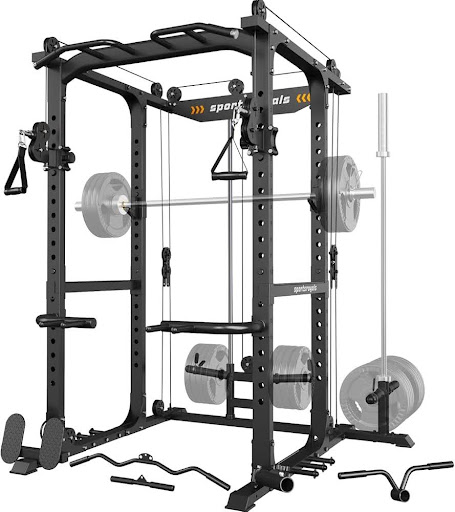When you think of weightlifting and serious strength training, one piece of equipment stands above the rest: the power rack. Also known as a power cage or squat cage, this robust framework provides the safety, versatility, and functionality to perform heavy compound lifts without requiring a spotter.
Power racks are indispensable for home gyms, commercial facilities, and athletes seeking maximum performance. Let’s explore what makes them essential and how to choose the right one, even referencing options from Dynamo Fitness in Australia.
What Exactly Is a Power Rack?
A power rack is a four-post steel cage with adjustable safety bars and J-hooks that hold barbells. It provides mechanical spotting, allowing you to push limits without risking injury. Common attachments—like cable pulleys, pull-up bars, dip stations, and plate storage—transform it into a fully functional training station.
Why You Need a Power Rack
A power rack offers several key benefits:
- Unmatched Safety: Safety and spotting arms catch failed lifts (including squats and bench presses) to prevent injury .
- Versatility in Training: From squats, deadlifts, and presses to pull-ups and rack pulls— and even advanced cable work—this is a multi-functional powerhouse .
- Enables Progressive Overload: Train alone with confidence as you increase strength safely.
- Expandable Design: Modular attachments allow customization to suit evolving fitness goals
- Commercial Durability: Made with thick steel and superior welding, these racks are built to last, even in heavy-use gym environments.
Core Features to Look For
📏 Build Quality and Steel Gauge
Look for heavy-gauge steel (11–13 gauge) with secure welding. Dynamo Fitness’s commercial-grade racks feature powder-coated steel for durability.
🗜️ Adjustable J-Hooks & Safety Bars
These components keep workouts safe, offering height flexibility and “bar-catching” support.
📦 Plate and Bar Storage
Integrated pegs and vertical bar holders keep the gym space tidy and accessible.
🏋️♂️ Pull-Up Bar Integration
Essential for bodyweight exercises, though ensure your ceiling provides enough clearance .
🔧 Modular Attachments
Landmine holders, band pegs, dip stations, and pulley systems allow broad exercise selection.
📏 Hole Spacing and Numbering
Fine 1–2 inch spacing with numbered holes ensures consistent setup, especially beneficial for moves like bench pressing.
Types of Power Racks
- Full Power Racks
- Four-post cages are ideal for heavy lifting and maximum attachment use. Weight capacities often exceed 1,000 lb.
- Half Racks
- Compact yet sturdy, ideal for smaller spaces with many similar attachments available .
- Combo Racks
- Feature integrated smith machines or lat pulldown systems, offering additional value for multifunctional.
- Wall-Mounted/Folding Racks
- Space-saving and foldable; great for home or garage gyms with limited room.
Power Racks in Homes & Gyms: Recommended Models
- Bells of Steel Hydra Rack
- Robust 3×3″ uprights, 1,000 lb capacity, and heavy-duty customization options.
- REP Fitness PR‑5000
- Versatile, fully modular power rack widely praised for build and performance.
- Titan Fitness T2 / T3 Series
- Budget-friendly racks ideal for beginners and small spaces.
- Force USA G20 Pro
- All-in-one trainer with cables and plates for total gym functionality.
- PRx Profile Folding Rack
- Space-saving rack that folds flush to the wall, suitable for tight home gyms.
Dynamo Fitness Power Racks in Australia
Dynamo Fitness offers a range of power racks suited for home and commercial use across Australia.
- Impact Fitness IMPC60: Affordable and versatile, includes pull-up bar and long safety arms.
- Reeplex PRC9000 & Commercial Power Racks: Heavy-duty, customizable racks with storage and attachments.
- Power Rack Packages: These bundles include rack, barbell, plates, bench, and lat pulldown—ideal for complete setups.
All racks feature sturdy frames, safety components, and numerous accessories to tailor the workout experience.
Choosing the Right Rack for Your Needs
| Consideration | Recommendation |
| Space | Full racks require room for movement and attachments; consider half or folding racks for smaller spaces. |
| Budget | Beginner racks start around $400 AUD; serious training setups can cost $1,000+ |
| Weight Capacity | Aim for 1.5× your max lift safely; home racks often support 500–1,000 lb . |
| Attachments | Choose based on your workouts—pull-up bars, dip handles, band pegs, cable systems, and storage horns. |
| Build Quality | Heavy-gauge steel and industrial finishes last longer and stay safer . |
| Safety Features | Numbered uprights, close hole spacing, and built-in rubbers improve usability . |
Real-World Performance and User Feedback
- GQ Magazine calls the Bells of Steel Hydra Rack the best overall due to its heavy build and customization.
- Self.com highlights the PR‑5000 and foldable options like the PRx Profile Rack as top picks for home gyms.
- Origin Fitness emphasizes modular attachments and customization as top-tier investment factors.
Conclusion: Invest in Performance, Safety & Versatility
Power racks are the foundation of strength and muscle-building routines. With safety features, extensive exercise options, and upgrade paths, they support all training levels—from beginner to elite athlete.
Brands like Dynamo Fitness in Australia provide commercial-grade racks and accessories, enabling you to build a gym that suits your goals. Whether you want the Impact IMPC60, Reeplex PRC9000, or a custom-fit rack package, these platforms are solid investments in your fitness journey.




